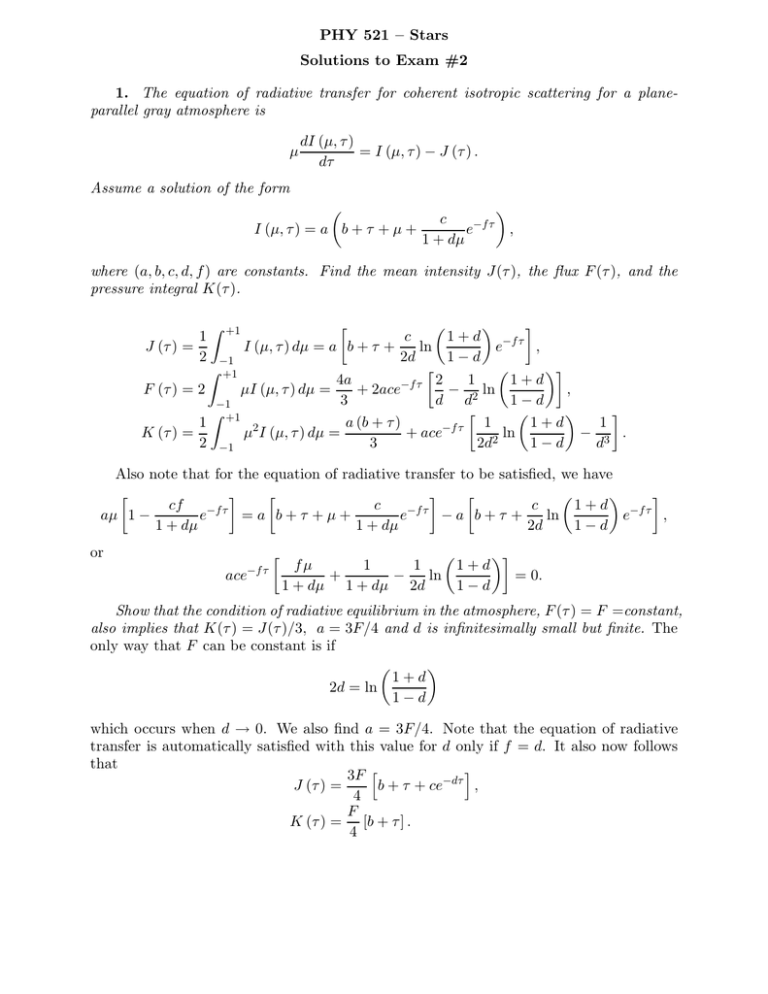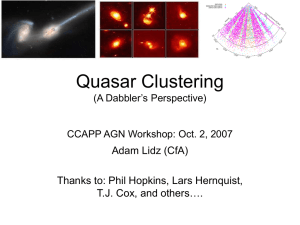PHY 521 – Stars Solutions to Exam #2
advertisement

PHY 521 – Stars Solutions to Exam #2 1. The equation of radiative transfer for coherent isotropic scattering for a planeparallel gray atmosphere is µ dI (µ, τ ) = I (µ, τ ) − J (τ ) . dτ Assume a solution of the form I (µ, τ ) = a b + τ + µ + c e−f τ 1 + dµ , where (a, b, c, d, f ) are constants. Find the mean intensity J(τ ), the flux F (τ ), and the pressure integral K(τ ). +1 c 1 + d −f τ , e I (µ, τ ) dµ = a b + τ + ln 2d 1−d −1 Z +1 1 1+d 4a −f τ 2 , + 2ace − ln F (τ ) = 2 µI (µ, τ ) dµ = 3 d d2 1−d −1 Z 1 +1 2 1 a (b + τ ) 1 1+d −f τ K (τ ) = − 3 . µ I (µ, τ ) dµ = + ace ln 2 −1 3 2d2 1−d d 1 J (τ ) = 2 Z Also note that for the equation of radiative transfer to be satisfied, we have c c 1 + d −f τ cf −f τ −f τ , =a b+τ +µ+ −a b+τ + e e e ln aµ 1 − 1 + dµ 1 + dµ 2d 1−d or −f τ ace 1 1 1+d fµ = 0. + − ln 1 + dµ 1 + dµ 2d 1−d Show that the condition of radiative equilibrium in the atmosphere, F (τ ) = F =constant, also implies that K(τ ) = J(τ )/3, a = 3F/4 and d is infinitesimally small but finite. The only way that F can be constant is if 1+d 2d = ln 1−d which occurs when d → 0. We also find a = 3F/4. Note that the equation of radiative transfer is automatically satisfied with this value for d only if f = d. It also now follows that i 3F h J (τ ) = b + τ + ce−dτ , 4 F K (τ ) = [b + τ ] . 4 In the limit when τ → ∞, J = K/3. The exact solution of the gray atmosphere problem can be written 3 J (τ ) = F [τ + q (τ )] , 4 √ where q(τ ) is the Hopf function. The exact solution has q(0) = 1/ 3 and q(∞) = 0.710446. Find the constants (b, c, d, f ) that result in radiative equilibrium and the correct Hopf function in the limits of τ = 0 and τ = ∞. Substitution yields q (τ ) = b + ce−dτ , q (0) = b + c, q (∞) = b so b = q (∞) = 0.71, c = q (0) − q (∞) = −0.1331. We already saw that f = d → 0. For this model, how much brighter would the center of the stellar disk appear compared to the limb of a star? This is the ratio √ b + 1 + c (1 + d)−1 I (µ = 1, τ = 0) = = 1 + 3 = 2.732. I (µ = 0, τ = 0) b+c Can this model generally satisfy the condition that there is no incoming radiation at the stellar surface? No incoming radiation at the surface is I(µ, 0) √ = 0 for µ < 0, or a(b+µ+c(1+d)−1) = 0 which is true only for µ = −b − c/(1 + d) = −1/ 3 = −0.577. For all other values of µ, the incoming intensity does not vanish. 2. The problem concerns the cooling of white dwarfs. Suppose that the conductivity in a white dwarf interior is so large, because of electron degeneracy, that the star is nearly isothermal with temperature T . However, there is an atmosphere and so the visible surface of the star has an effective temperature Tef f 6= T . Approximate the effect of the atmosphere through Tef f = KT 7/8 , where K is a constant. Assume the mass M and radius R of the white dwarf remain constant as it cools. Although the pressure in the white dwarf interior is dominated by degenerate electrons, the heat capacity in the interior is dominated by ions. Approximate the total heat capacity by 3 CV = N kB 2 where N is the number of ions in the interior. Also assume that the ions are all C12 . The white dwarf cools primarily by thermal emission of radiation from the surface. What is the slope d ln L/d ln Tef f of the cooling trajectory in the Hertzsprung-Russel diagram? 4 From the fact that L = 4πR2σTef f we have trivially d ln L/d ln Tef f = 4 if R = constant. How does this compare to the slope for lower Main Sequence stars? On the lower Main Sequence, we found that this slope is 284/69=4.12, assuming p-p cycle for energy generation and Kramer’s opacity. Suppose that white dwarfs have been born at a constant rate over the age of the Galaxy TG . What is the smallest luminosity and effective temperature a white dwarf with mass of 1 M⊙ and radius 1000 km would have at the present time? The smallest luminosity and effective temperature would occur for the oldest white dwarfs, those with age τ = TG . The total thermal energy of the white dwarf, by assumption, is 3 M N0 E = CV T = kB T. 2 12 Thus M N0 kB dT dE = = 4πR2σK 4 T 7/2 . L=− dt 8 dt This has the solution −2/5 80πσK 4R2 −5/2 T (t) = t + T0 , M N0 k B where T0 = T (0). At large times, the T0 term is unimportant. We have for the assumed situation, t = TG ≃ 1010 yr and cgs units Thus −2/5 T (TG ) ≃ 3 · 10−10 K 4 ≃ 6750K −8/5 K. Tef f (TG ) ≃ 2240K −2/5 K. Typically, you will find that K ≈ 0.1, so Tef f ≈ 5600 K. Also, 4 −6 −8/5 L (TG ) = 4πR2σTef L⊙ ≈ 1.5 · 10−4 L⊙ . f ≃ 3.8 · 10 K Finally, sketch the behavior of the relative number of white dwarfs in our Galaxy in a logarithmic luminosity interval as a function of luminosity. The number of white dwarfs in a given logarithmic luminosity interval increases with time up to the time TG when the number drops sharply. d ln L/d ln t = −7/5 implies d ln N/d ln L ∼ (d ln t/d ln L) ∼ −(5/7). 3. Consider a binary star with masses M10 and M2 initially in a circular orbit with semi-major axis a0 . A supernova occurs in star 1 resulting in an immediate mass loss of ∆M = M10 − M1 . If the supernova remnant receives no kick, i.e., its spatial velocity immediately after the explosion is the same as before, what is the maximum mass loss that can occur yet still result in a bound binary? Express your answer in terms of a fraction of the total initial mass M = M10 + M2 . The general equation for the total energy of a binary with components m1 and m2 is E=− 1 m1 m2 Gm1 m2 1 =− + µV 2 2 a r 2 where m = m1 + m2 , µ = m1 m2 /m is the reduced mass, a is the semi-major axis, r is the separation, and V is the relative velocity of the two stars. If the orbit is elliptical, r and V change with time. For two stars initially in a circular orbit, the total energy is E0 = − 1 GM10 M2 1 = − µ0 V02 , 2 a0 2 where r = a0 is the semi-major axis and V = V0 is the relative velocity of the two stars. Note µ0 = M10 M2 /M and M = M10 + M2 . After the explosion, if the star is bound, the total energy is GM1 M2 1 1 GM1 M2 + µV02 ; =− E=− 2 a a0 2 if there is no kick, V = V0 and r = a0 . a is the new semi-major axis and µ = M1 M2 /(M − ∆M ) where ∆M = M10 − M1 is the mass lost in the explosion. Therefore we have GM = V02 . a0 In the limiting case for a bound orbit, a → ∞ or E = 0, so 1 G (M − ∆M ) = V02 . a0 2 Combining these gives ∆M = M/2 as the maximum amount of mass loss; the fractional loss is 1/2. In some neutron star binaries, it is obvious that explosions have occurred in which more mass loss occurred than predicted above, yet the binaries are still bound. How could this happen? There must have been a kick and/or the initial orbit was not circular. 4. In this problem consider an explosion that occurs within a star of uniform density ρ, uniform temperature T , and mass M . Immediately after the shock wave from the explosion reaches the surface, the stellar gas is so hot that it is radiation-pressure dominated. Energy diffuses out of the star by radiative transport, and the opacity is due mostly to electron scattering. The total energy imparted to the matter is of order ESN = εr V , where εr is the energy density of radiation and V is the initial stellar volume 4πR03/3 with R0 the initial stellar radius. Assuming the stellar structure radiative transfer equation holds throughout the star, show that the luminosity at the stellar surface is L∝ ESN R0 M κ where κ is the opacity. The equation of radiative transport, one of the stellar structure equations, is 4πr 2 ac dT 4 L (r) = − 3 κρ dr where κ is the opacity. Also, under the assumed conditions ESN = 4πR3 4π 4 3 M 4 εr = aT R = aT . 3 3 ρ Approximating dT 4 /dr at r = R0 by −T 4 /R0 we find 4π cESN R0 L (R) = . 3 κM Estimate the ratio ESN /M for a Type Ia supernova. A Type Ia supernova involves the thermonuclear detonation of a white dwarf. Figure the energy release per gram is the difference between the binding energy of C12 and Ni56 , which is about 1 MeV per baryon or 1018 erg g−1 . Assuming that this ratio is about the same for a gravitational collapse (Type II) supernova, why is the initial luminosity of a Type Ia supernovae much, much fainter than a Type II? The initial size (radius R0 ) of the progenitor star of a Type Ia (white dwarf) is much, much less than that of a Type II (red or blue supergiant). At late times, both types of supernovae exhibit light curves that exponentially decay with a time constant of about 80 days. Why is this? This timescale is the radioactive decay time of Co56 , an intermediate nuclide in the decay of Ni56 to Fe56 with a halflife of 77 days. Most of the late-time light curves of all supernovae is due to this radioactive decay chain. 5. Assume the core of a red giant star is isothermal, with Ts ≃ 107 K and a core mass Ms ≃ 1 M⊙ . Assume the pressure in the core is due to an ideal gas. Beyond its boundary a thin layer produces essentially all the star’s luminosity. Also assume the red giant’s envelope is radiative and use the equations of hydrostatic equilibrium, the ideal gas law, and radiative transfer to show that the stellar radius is approximately 1000 R⊙ . In the envelope, assume power law solutions −a −b −c d r r r r P = Ps , T = Ts , ρ = ρs , M = Ms Rs Rs Rs Rs where Rs is the core radius and the s subscript indicates other conditions there. Assume Kramer’s opacity. The perfect gas law says that a = b+c. The definition of the mass implies that d = 3−c. The equation of hydrostatic equilibrium implies that −a−1 = d−c−2, and using Kramer’s opacity with the radiative transport equation and a constant luminosity gives 1 − 7.5b + 2c = 0. Solving, we find a = 42/11, b = 10/11, c = 32/11, d = 1/11. The equation of hydrostatic equilibrium evaluated at the edge of the core gives µ GMs Ts = . N0 kB a Rs With Ts = 107 K and Ms = M⊙ you get Rs = 0.4R⊙ . If we evaluate the value of r = R for T = Tp = 3500 K, the photospheric temperature of a red giant, you find b 7 10/11 Ts 10 R = Rs R⊙ ≃ 550R⊙ . = .4 Tp 3500

